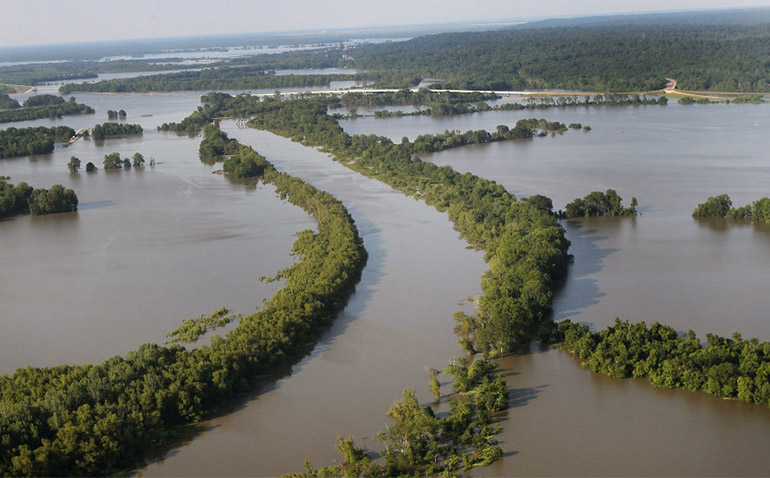
BPF’s View on the Yazoo Backwater Pumps
About 600,000 acres in the Delta is flooded from rainwater trapped outside the Mississippi River levee. Rainwater in the Yazoo Basin can’t flow into the river when it’s above flood stage.
Another 600,000 acres in Mississippi inside the levee is also flooded. It has been flooded longer and higher than the Delta by the river which has been above flood stage and outside its channel since January.
This flood is the longest ever because of more rain and not enough discharge to the Gulf. God sends more rain. The US Army Corps of Engineers restricts its discharge.
The Pumps will pour water out of the Delta’s boot over the levee at Vicksburg onto people below. They will make flooding higher and longer inside the levee. Landowners in the Delta outside the levee will benefit. Landowners inside the levee will suffer.
The pumps won’t increase the discharge to the Gulf. They just pass the flood downriver onto someone else. That’s the history of other divisive Corps flood control projects. That’s why the river is full now.
It’s time to increase the discharge to the Gulf at the Old River Control Structure down the short steep Atchafalaya River to lower ground to the west. And to decrease the discharge to the east at the Bonnet Carré which protects New Orleans. It’s discharge harms marine life in the Mississippi Sound and reduces flooding very little upriver.
More flow down the Atchafalaya will lower the Mississippi and decrease flooding. It will benefit those inside and outside the levee. We need to stand and work together on this.
To sign up for MS River Updates from BPF, subscribe here.

Hallelujah. Great explanation.
If you live down river in between the ms River levee,, your asking for trouble,,, so the water we pump off out of the south delta region won’t affect the water levees according to the Corp but about the thickness of a dime,, we were promised these pumps from the start back in the 1940’s and I damn well think we need them,,
So, is correcting the downriver flow restrictions the better solution to major south delta flooding long term than building pumps? Will the pumps prevent major South Delta flooding in the next major flood scenario if sedimentation continues to increase at projected rates? What is the cost-benefit ratio of the pumps? Is it true that if the pumps were currently in place they would have only reduced the flooding area by a third to a half?
Foster Dickard, No, if there are downriver flow restrictions between Vicksburg and The Gulf, removing them is not a solution to major flooding in the Yazoo Backwater Area. According to this article the flow has been restricted since 1973 yet the rainfall amounts in MS River Basin in 1973 and 2019 are comparable. Flooding in the Backwater Area is the result of trapped rainfall yet Backwater levels rose 3 feet higher in 1973 than in 2019.
Yes, pumps will prevent major South Delta flooding PERIOD!
Cost benefit is 1.5:1.0
You can twist the “flood reduction” numbers many ways undoubtedly. There are 189,600 acres of wetlands in the YBA and those will purposefully NOT be drained by pumps. There are 316,000 acres of farmland and every single bit of it would have been unflooded by April 1st. In 2019, 225,000 acres of that land remained flooded until August and has NO CROP. Not a single home or business would have been flooded with pumps in place. The entire Eagle Lake community would have seen recreational and living conditions as normal with pumps in 2019. The Corps determined in 2007 there is NO adverse impact to communities downstream or in the immediate vicinity from pumping 14,000cfs at Steele Bayou even at the highest flood levels. Currently the gates are passing 45,000cfs via gravity flow. Absolutely none of the arguments against pumps are valid, especially the “protecting the environment” arguments, in 2019, the forced flooding impacted over 120,000+ acres of “temporary wetlands” by covering them with at least 10’ of water for 8 months of the growing season rendering them non functioning wetlands. Excessive flooding is by far the single most destructive force to wetlands in this area.